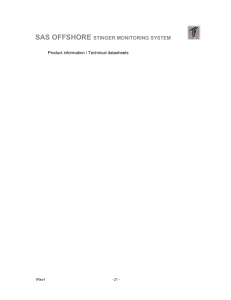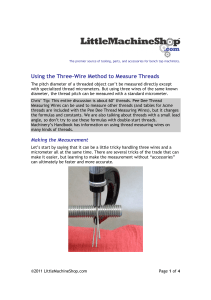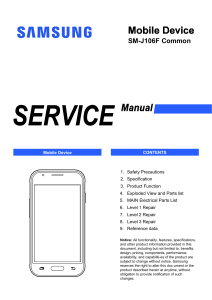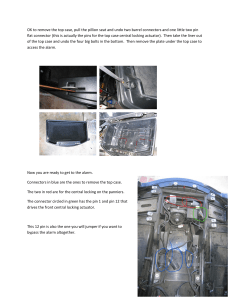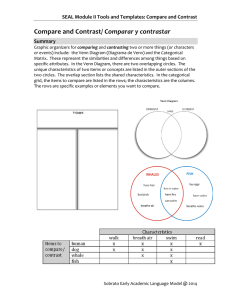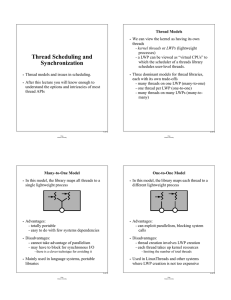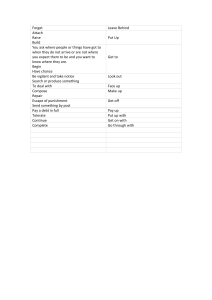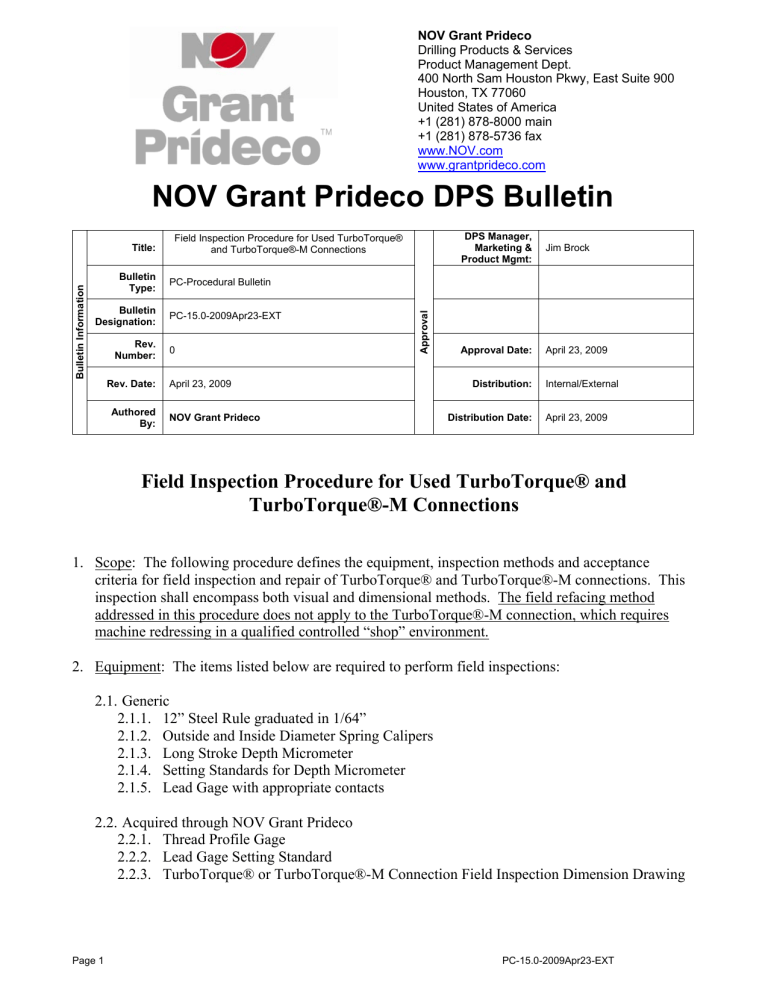
NOV Grant Prideco Drilling Products & Services Product Management Dept. 400 North Sam Houston Pkwy, East Suite 900 Houston, TX 77060 United States of America +1 (281) 878-8000 main +1 (281) 878-5736 fax www.NOV.com www.grantprideco.com NOV Grant Prideco DPS Bulletin Bulletin Type: Bulletin Designation: Rev. Number: Rev. Date: Authored By: Field Inspection Procedure for Used TurboTorque® and TurboTorque®-M Connections DPS Manager, Marketing & Product Mgmt: Jim Brock Approval Date: April 23, 2009 PC-Procedural Bulletin PC-15.0-2009Apr23-EXT 0 Approval Bulletin Information Title: April 23, 2009 NOV Grant Prideco Distribution: Distribution Date: Internal/External April 23, 2009 Field Inspection Procedure for Used TurboTorque® and TurboTorque®-M Connections 1. Scope: The following procedure defines the equipment, inspection methods and acceptance criteria for field inspection and repair of TurboTorque® and TurboTorque®-M connections. This inspection shall encompass both visual and dimensional methods. The field refacing method addressed in this procedure does not apply to the TurboTorque®-M connection, which requires machine redressing in a qualified controlled “shop” environment. 2. Equipment: The items listed below are required to perform field inspections: 2.1. Generic 2.1.1. 12” Steel Rule graduated in 1/64” 2.1.2. Outside and Inside Diameter Spring Calipers 2.1.3. Long Stroke Depth Micrometer 2.1.4. Setting Standards for Depth Micrometer 2.1.5. Lead Gage with appropriate contacts 2.2. Acquired through NOV Grant Prideco 2.2.1. Thread Profile Gage 2.2.2. Lead Gage Setting Standard 2.2.3. TurboTorque® or TurboTorque®-M Connection Field Inspection Dimension Drawing Page 1 PC-15.0-2009Apr23-EXT 3. Preparattion: All thrreads and botth torque shooulders shall be cleaned sufficientlyy to allow forr visual inspectioon. Both staarting threadds of the pin and box connnections muust be cleaneed using a “ssoft wheel” or o similar bu uffing methood. 4. Visual innspection: 4.1. Prim mary Should der (Seal): Reefer to the “T TurboTorquue® or TurbooTorque®-M M Connectionn Field Insppection Dimension” draw wing for term minology annd shoulder locations. Thhe primary shoulder s surfface shall be free of gallss, nicks, wasshes, fins, orr other condiitions that exxceed the lim mits of par.. 4.1.1 and 4.1.2 (below)). 4.1.11. Damage that exceedss 1/32” in deepth and crossses more thhan approxim mately 30% of o the radial width h of the prim mary shouldeer shall be reemoved. 4.1.22. Repair by y refacing methods m shalll only removve enough material m to reppair the dam mage. A maximum of o 1/32” of material m mayy be removedd during eacch refacing operation o witth a combined total t materiaal removal off 1/16” befoore rethreadinng is requireed. 44.1.2.1. H-Series™ H Beenchmark: After A refacinng repair, a minimum m lenngth of 1/16” (.062””) shall remaain on the boox refacing benchmark, b a 3/16” maximum and m (.1888”) shall remain r on thhe pin refacinng benchmarrk. Rethreadding is requiired if excess material is removeed. See skettch below. New Pin Pinn Max Reface New w Box Box Maxx Reface 44.1.2.2. Xmark™ X Bennchmarks: After A refacinng repair, a visible v step on o the benchhmark shall remain r on thhe primary shhoulder. Thhe step is a neecessary inddicator that a bench hmark is stilll present. Reethreading iss required if there is no visible v benchhmark. See sk ketch below.. Page 2 of 6 PC-15.0-2009Ap pr23-EXT New Benchmark Single Reface Max Reface (With visible step) 4.2. Secondary Shoulder (Internal Torque Shoulder): The Secondary Shoulder is not a sealing surface. Damage to this surface is not critical unless the damage interferes with the make-up, driftability, or torque capacity of the connection. Dents, scratches, and cuts do not affect this surface unless these exceed 1” in width and cause the connection to be rejected due to shortening of the shoulder-to-shoulder length. Filing may be used to repair material protrusions, which extend from the face. Connection length readings shall not be taken in damaged areas. 4.3. 15° Seal: TurboTorque®-M connection contains a 15° metal-to-metal sealing surface near the pin and box secondary shoulders. This is the primary sealing surface for the TurboTorque®-M connection. This surface is allowed to contain round pit type defects in the contact area of the seal surface up to 1/32” in diameter and not exceeding 1/32” in depth. Multiple pits of this type are acceptable provided there is at least 1” circumferential separation between them. Circumferential lines or marks are acceptable in this surface provided they cannot be detected by rubbing a fingernail across the surface. The following “Pin Seal” and “Box Seal” diagrams show areas of the seal that may contain damage exceeding that previously stated in this procedure. The area on the pin seal within 0.060” of the minor pin nose diameter is a noncontact surface and damage in this are does not affect sealing. The area on the pin seal within 0.060” of the major pin nose diameter may also contain damage or pitting (in addition to the area on the pin seal within 0.060” of the minor pin nose diameter), provided that the balance of the seal contact surface is without damage. The area on the box seal within 0.188” of the major box cylinder contains the non-contact portion of the box seal and that portion of the seal that corresponds to the first 0.060” of the pin seal. Damage or pitting is permitted in this area of the box seal provided that the balance of the seal contact surface is without damage. Page 3 of 6 PC-15.0-2009Apr23-EXT Box Seal 0.060 0.060 0.188 Pin Seal 4.4. Threads: The stab flank to crest radius of the starting 4 to 5 threads of the pin and box connections round off during break-in and normal operation. This condition is normal and does not affect the service of the connection. The remaining thread flank surfaces shall be free of damage that exceeds 1/16” in depth or 1/8” in diameter. Thread roots shall be free of damage that extends below the radius. Thread crest shall be free of damage that would interfere with make-up. Material that protrudes beyond the thread profile should be removed using a round cornered triangle hand file or soft buffing wheel. 4.5. Profile: The thread profile shall be verified along the full length of complete threads in two locations at least 90° apart. The profile gage must mesh evenly in the threads and show normal contact. If the profile gage does not mesh in the threads, lead measurements shall be taken. 4.6. Coating: Threads and shoulders that are repaired by filing or refacing must be protected by phosphate coating or by using copper sulfate. 5. Dimensional Inspection: 5.1. Lead: If the profile gage indicates that thread stretch has occurred, both thread leads shall be verified individually (in lead) and jointly (between leads). Connections failing the below inspections in par 5.1.1 or 5.1.2 shall be inspected for cracks and if none are found, rethreaded. 5.1.1. Three Threads per Inch (3 TPI) 5.1.1.1. The 1st lead shall be measured over 6 threads (2” interval) and shall not exceed 0.006”. 5.1.1.2. By advancing one thread, the 2nd thread lead shall be measured over 6 threads (2” interval) and shall not exceed 0.006”. 5.1.1.3. Joint thread leads shall be measured over a 5 threads (1-1/2” interval) and shall not exceed 0.005”. 5.1.2. Three and a Half Threads per Inch (3.5 TPI) 5.1.2.1. The 1st lead shall be measured over 4 threads (1” interval) and shall not exceed 0.003”. 5.1.2.2. By advancing one thread, the 2nd thread lead shall be measured over 4 threads (1” interval) and shall not exceed 0.003”. Page 4 of 6 PC-15.0-2009Apr23-EXT 5.1.2.3. Joint thread leads shall be measured over 7 threads (2” interval) and shall not exceed 0.006”. 5.2. Box Outside Diameter: The outside diameter of the box shall be measured at a distance of 5/8”-7/8” from the primary make-up shoulder. Measurements shall be taken around the circumference to determine the minimum diameter. (Reference the appropriate Field Inspection Drawing) 5.3. Box Counterbore Diameter: The box counterbore diameter shall be verified. This dimension can be used to determine box swell and the need to verify connection length. 5.4. Box Counterbore Wall Thickness: The wall thickness between the “Box Outside Diameter” and “Box Counterbore Diameter” shall be measured to insure that it exceeds the minimum dimension. (Reference the appropriate Field Inspection Drawing) 5.5. Box Connection Length: The distance between the primary and secondary shoulders shall be verified in two locations 180° apart. (Reference the appropriate Field Inspection Drawing) 5.5.1. Repair of connection length non-conformances may be accomplished as noted below. 5.5.1.1. If the connection length exceeds the specified dimension, repair by refacing the primary shoulder. 5.5.1.2. If the connection length is less than the specified dimension, repair by refacing the secondary shoulder. 5.5.1.3. Refacing limits are the same as for repair of damaged shoulders. 5.5.2. Repair by Refacing – General 5.5.2.1. Refacing may be required due to torque shoulder damage and/or connection length discrepancies. Connection lengths must be held to the specifications on the appropriate Field Inspection Drawing. 5.5.2.2. Machine refacing in a lathe is the preferred method. 5.5.2.3. Portable field refacing units designed specifically for NOV Grant Prideco TurboTorque® connections are acceptable. A minimum of four measurements shall be taken when using a portable field refacing unit. The variability of face flatness and squareness is introduced and should be monitored. Should any measurement be found to be outside the drawing limits, the connection will be deemed as rejected. 5.6. Pin Nose Diameter: The outside diameter of the pin nose shall be verified. This dimension can be used to test for pin nose swell and the need to verify connection length. 5.7. Pin Connection Length: The distance between the primary and secondary shoulders shall be verified in two locations 180° apart. (Reference the appropriate Field Inspection Drawing) 5.7.1. Repair of connection length non-conformances may be accomplished as noted below. 5.7.1.1. If the connection length exceeds the specified dimension, repair by refacing the secondary shoulder (pin nose). 5.7.1.2. If the connection length is less than the specified dimension, repair by refacing the primary shoulder. Page 5 of 6 PC-15.0-2009Apr23-EXT 5.7.1.3. Refacing limits are the same as for repair of damaged shoulders. 5.7.2. Repair by Refacing – See section 5.5.2 5.8. Tong Length: A minimum tong space requirement of 6" for pins and a minimum box tong space equal to the connection length +1" or 8" minimum, whichever is greater. 6. Shop Redressing of TurboTorque®-M Shoulders and Radial Seal: To correct connection length or damage to sealing surfaces, the TurboTorque®-M connection must be redressed by facilities that have been specifically qualified by NOV Grant Prideco to perform this operation. All three surfaces (Primary shoulder, Secondary shoulder, and 15° Seal) shall be redressed in one operation in accordance with Redressing Thread Drawing. See requirements for refacing benchmark after machining (Para. 4.1.2. above.) 7. Re-threading: This method shall be used to repair connections that fail to meet the requirements stipulated in this inspection procedure. Performance of this operation may not require complete removal of the thread body if sufficient material can be removed to comply with the new product requirements. The connection does not have to be “blanked”; however, all torque shoulders, seal surfaces, and thread elements must be machined to 100% “bright metal”. This is not necessary for cylindrical diameters. After completion, the connection must be hot phosphate coated. (Copper Sulfate is not an acceptable substitute for re-threaded connections.) 7.1. Bevel Diameter: If the tool joint outer diameter falls below the bevel diameter, a 1/32” by 45 degree chamfer shall be used. The exact value of the bevel diameter is indicated in the “TurboTorque® or TurboTorque®-M Connection Field Inspection Dimension” drawing for the specified connection. Due to insufficient room to machine the Xmark™ benchmark, the Xmark shall be replaced with an H-Series™ Benchmark. Page 6 of 6 PC-15.0-2009Apr23-EXT
